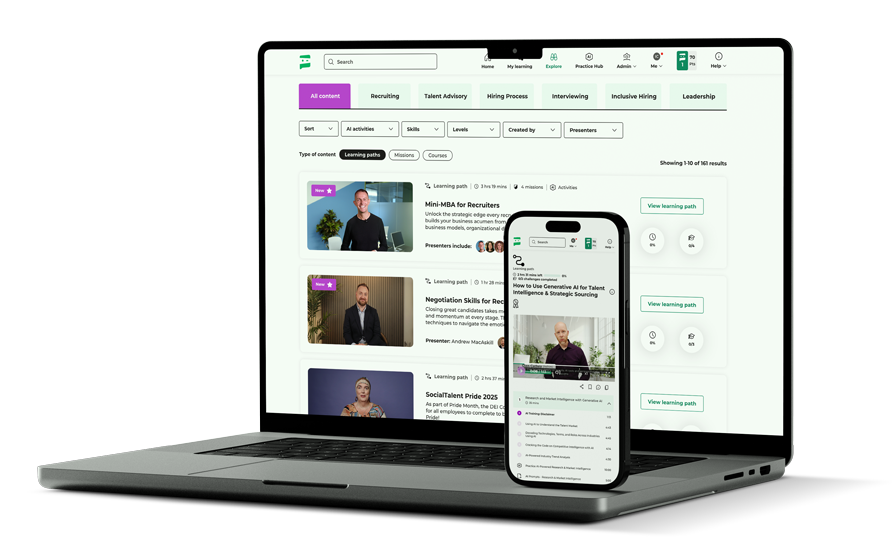
By Sean Parnell
Sourcing isn’t just about finding candidates—it’s about building a strategy that consistently delivers results. We recently had the opportunity to sit down with Glen Cathey, Head of Talent Advisory at Randstad and a pioneer in sourcing, who shared his blueprint for mastering the art and science of sourcing.
Timestamps:
00:21 Meet Glen Cathy: The Sourcing Legend
01:34 Glen’s Journey in Recruiting
02:40 Exotic Sourcing Explained
03:51 The Essence of a World-Class Sourcer
08:56 The Importance of Sourcing Playbooks
13:21 Soft Skills in Sourcing
22:11 Time Management for Sourcers
28:43 AI in Sourcing: Myths and Realities
40:57 Conclusion and Future Insights
Also available on: LinkedIn, Spotify, and Apple Podcasts!
Key Takeaways
1. The Importance of a Sourcing Playbook
Glen makes it clear: a structured, standardized sourcing playbook is crucial for consistent, effective results. “Eighty percent or more of your roles are probably going to be filled by the first five steps in your playbook,” he explained. Without a documented process, teams risk inefficiency and inconsistency, as each recruiter may follow a different, often unconscious, process. “If you don’t have people following the same general process, you’re going to have inconsistent results,” Glen said, stressing the need for a logical, unified approach.
2. From Boolean Black Belt to Industry Leader
Glen’s journey into sourcing started in 1997 at a small staffing company, where he recognized the potential of internal databases. His innovative approach to Boolean search and talent acquisition led him to create the famous Boolean Black Belt blog, a resource that has shaped the sourcing industry. As Johnny shared, Glen’s content has been a huge influence on his own sourcing career.
“I was just fascinated with your mind and the way you thought about sourcing,” Johnny said. For Glen, sourcing has always been about problem-solving, focusing on probability-driven methods to find candidates quickly and efficiently.
3. Exotic Sourcing and Efficient Practices
While many recruiters focus on “exotic sourcing” — the idea of finding candidates in obscure places — Glen believes in maximizing the potential of internal databases. He shared how, in his early days, he made record hires using his company’s internal database, leading him to question why so many recruiters rely on external internet searches. “Why is no one talking about leveraging the internal database?” Glen asked. For him, focusing on internal resources is more effective and less time-consuming.
He also emphasized the importance of deliberate practice in sourcing: refining searches, analyzing results, and continuously improving the process to increase efficiency. “You have to understand what you’re looking for,” Glen said. “If you don’t, you’re unlikely to produce the right result.”
4. The Human Touch: Empathy, Humor, and Influence
Glen believes that while technical skills are essential, soft skills like empathy and humor are equally important in sourcing. “There’s science behind why people take action,” he explained, referring to the psychology of influence and how understanding human behavior can make outreach more effective.
Glen has a unique strategy called “Go Ugly Early,” which involves addressing less attractive aspects of a job upfront. He shared how, early in his career, he would save challenging aspects, like below-market compensation, until the end of a conversation, only to see the discussion fall apart. By bringing up these challenges early, Glen discovered that candidates who accepted them were genuinely interested in the role, allowing the rest of the conversation to flow more smoothly.
5. Time Management: Activity Over Time
Managing time is critical in high-volume hiring, but Glen reframed the conversation around “activity management” rather than traditional time-blocking. “It’s not about what you’re doing with time, it’s what you’re doing in time,” he explained. Rather than rigidly setting time blocks, Glen advocates focusing on specific activities, such as sourcing or outreach, and sticking to them until they are completed.
By focusing on productivity and setting activity goals, Glen has been able to consistently meet and exceed targets without sacrificing quality. His approach combines quality, quantity, and speed — the three key pillars of productivity in sourcing.
6. AI’s Role in Sourcing
As AI becomes more integrated into recruitment, Glen acknowledged its growing importance but cautioned that human expertise is still irreplaceable. AI can assist with tasks like writing Boolean search strings or filtering resumes, but it lacks the critical thinking and pattern recognition that experienced sourcers bring. “AI can do some of the heavy lifting, but it can’t replace the human ability to see potential in a candidate,” Glen said.
He also noted that the quality of AI-driven searches is only as good as the data it’s fed. A job description, often used as the basis for a search, may not fully represent the true requirements of the role. “There’s a flaw in relying on job descriptions alone,” Glen remarked. Human input is necessary to ensure that AI is targeting the right candidates and that nuances aren’t missed.
Conclusion
Glen Cathey’s insights offer a masterclass in sourcing. From building a structured playbook to managing activities efficiently, his approach emphasizes the importance of consistency, critical thinking, and the human touch. As AI continues to evolve, Glen’s methods show that human expertise remains the key to sourcing success.


